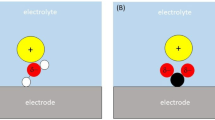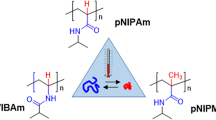Abstract
It was established that the said substances possess comparatively low specific electrical resistence (compared to similar substances having a tertiary nitrogen atom) which decreases exponentially with increasing temperature. The investigated molecular complexes have the properties of thermistors. On the basis of the experimental data the electron constant „B”, the temperature coefficient „α” and the energy of activation „ΔE” were calculated. The values of the energy of activation are within the so far established limits (from 0 upto 1.5 eV) for complexes with charge transmittance, such as the investigated substances.
Zusammenfassung
Es wurde die elektrische Leitfähigkeit einiger Molekülkomplexe der (1-Aryl-3-isoindolyl-)(1-aryl-3-pseudoisoindolenyliden)-arylmethane und ihrer Kobaltderivate mit Jod und Brom untersucht. Festgestellt wurde, daß diese Verbindungen einen verhältnismäßig niedrigen spezifischen elektrischen Widerstand (im Vergleich mit anderen ähnlichen Verbindungen, die ein tertiäres Stickstoffatom enthalten) haben, der sich exponentiell mit der Erhöhung der Temperature vermindert. Die untersuchten Molekülkomplexe verhalten sich als Thermistoren. Auf Grund der Versuchsdaten wurden die elektronische Konstante „B”, der Temperaturkoeffizient „α” und die Aktivierungsenergie „ΔE” errechnet. Die Aktivierungsenergiewerte liegen in den bis jetzt festgestellten Grenzen (von 0 bis 1,5 eV) für derartige Ladungsübergangskomplexe.
Similar content being viewed by others
Literatur
Ch. P. Ivanov undI. K. Svirevski, C. r. Acad. bulg. Sci.21, 9, 901 (1968); Chem. Abstr.70, 28, 752 r (1969).
Ch. P. Ivanov undI. K. Svirevski, C. r. Acad. bulg. Sci.22, 2, 169 (1969); Chem. Abstr.70, 23, 267 (1969).
Tsch. P. Ivanov undAl. Draganov, Mh. Chem.99, 1990 (1968).
I. K. Svirevski undCh. P. Ivanov, C. r. Acad. bulg. Sci.22, 6, 683 (1969); Chem. Abstr.71, 87, 252 w (1969).
Tsch. P. Ivanov undAl. Draganov, Jb. Chem. Technol. Inst. (Sofia)13, 1, 95 (1966).
H. Akamatu, H. Inokuchi undY. Matsunaga, Nature173, 168 (1954).
H. Akamatu undH. Inokuchi, J. Chem. Physics18, 810 (1950).
S. Ivanov, D. Goglev, I. Dantschev, P. Petrov, L. Biheva undI. Janatschkova, Jb. Masch. El. Inst.13, 1, 177 (1964).
I. F. Woloschin, A. S. Kasperovitsch undA. G. Schaschkov, Halbleiterthermowiderstände (полупроводниковъeе сопотивнения). Minsk: Isd. AN SSSR. 1959.
G. C. Martin undA. R. Ubbelohde, J. Chem. Soc.1961, 4948.
Author information
Authors and Affiliations
Additional information
Mit 1 Abbildung
Rights and permissions
About this article
Cite this article
Svirevski, I., Petrov, P. Über die elektrische Leitfähigkeit von Jod- und Brommolekülkomplexen der (1-Aryl-3-isoindolyl-) (1-aryl-3-pseudoisoindolenyliden)-arylmethane und ihre Metallderivate. Monatshefte für Chemie 104, 68–73 (1973). https://doi.org/10.1007/BF00911147
Received:
Issue Date:
DOI: https://doi.org/10.1007/BF00911147




